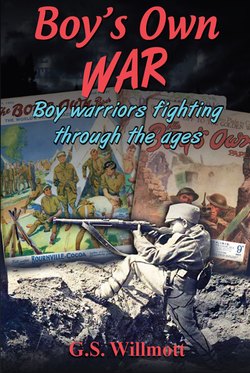Читать книгу Boy's Own War - G. S. Willmott - Страница 7
На сайте Литреса книга снята с продажи.
Introduction
ОглавлениеThis book is about war; so how do we define war?
“War is a state of armed conflict between autonomous or coalitions of such organizations. It is generally characterized by extreme collective aggression, destruction, and usually high mortality. The set of techniques used by a group to carry out war is known as warfare. An absence of war is usually called peace.
While some scholars see warfare as a universal and ancestral aspect of human nature, others argue that it is only a result of specific socio-cultural or ecological circumstances.
In 2013 war resulted in 31,000 deaths down from 72,000 deaths in 1990. The death toll in 2014 would be even greater with the wars in Syria, Iraq and northern Africa raging. The deadliest war in history, in terms of the cumulative number of deaths since its start, is the Second World War, with 60–85 million deaths, followed by the Mongolian Conquests. Proportionally speaking, the most destructive war in modern history is the War of the Triple Alliance, which took the lives of over sixty per cent of Paraguay's population.
In 2003, Richard Smalley identified war as the sixth (of ten) biggest problems facing humanity for the next fifty years. War usually results in significant deterioration of infrastructure and the ecosystem, a decrease in social spending, famine, large-scale emigration from the war zone, and often the mistreatment of civilians.
‘Total war is warfare that is not restricted to purely military targets, and can result in massive civilian casualties’
Wikipedia
This definition does not mention children however, since time immemorial, children have been fighting along side the grown ups. During the age of chivalry, Pages as young as ten followed their masters into war particularly during the Crusades. Drummer boys marched in front of Napoleon’s army’s as they did leading the British into battle. Both the Union and Confederate armies also used them extensively during the American Civil War.
The First World War was the first wholesale use of children, boys as young as twelve were fighting in the trenches.
It is estimated over 700,000 boys under the age of eighteen fought coming from all sides with over 100,000 dying in the “War to End all Wars”.
Although the same participation rate was not as great in the Second World War many still fought particularly from Germany. Hitler used his “Hitler Youth” as cannon fodder when the Russians were invading Germany and ultimately Berlin. It is estimated that close to 30,000 boys and girls lost their lives trying to defend Germany and their Fuhrer.
So now that the world has learned from these ferocious wars and we have become much more sophisticated and knowledgeable does child exploitation in war still go on? Yes, unfortunately more now, than ever before.
The use of child soldiers is far more widespread than many can believe; current estimates are that over 300,000 children under the age of eighteen are fighting with machine guns and machetes in war zones around the globe.
It might be argued that eighteen isn’t that young, however the average age of these warriors is twelve. So far, the youngest captured fighting in Uganda was five. In Columbia a terrorist bomber was captured, he was seven.
It’s not just boys fighting, 30% of the armies employing children also use girls, these girls are being used to fight in approximately fifty-five countries around the world.
A frightening statistic is children currently serve in 40% of the world’s armed forces including rebel groups and terrorist organisations such as Boko Haram and I.S.
It’s not just in the war zones where children are exploited up to half a million children are serving in the armed forces of countries not currently engaged in war.
These kids aren’t flocking to recruitment stations, they are being abducted from their villages and forced to engage in unspeakable atrocities to harden their resolve.
They then partake in raids where whole villages are either massacred or kidnapped. The boys are converted into terrorists and the girls into sex slaves.
With an abundance of child recruits, warlords are more prevalent to initiate new conflicts – their supply chain is never ending.
The legacy they leave behind when these conflicts eventually end are battle scared children that require re education and counselling for many years.
Boys Own War is a book that will shock you but hopefully also educate you to the horrors of war and the effect it has on our greatest assets…the children.
Explanation of Ranks and Infantry Organisation
Throughout this book terms will be used which may be unfamiliar to the reader.
Infantry Groups
| Platoon | 24- 48 men comprising 3 to 4 Sections |
| Company | 120 men comprising 3 to 4 Platoons plus HQ support. |
| Battalion | 700-800 men comprising 3 to 4 Companies plus HQ support. |
| Brigade | 3000-4000 men comprising 3 to 4 Battalions plus HQ support. |
| Division | 12000-14000 men comprising 3 to 4 Brigades plus HQ support. |
| Corps | 30,000-40,000 men comprising 3 to 4 Divisions plus HQ support |
Infantry Ranks
PrivateBasic rank.
Lance CorporalFirst possible promotion from Private.
SergeantSecond in command of a platoon.
Staff SergeantAdministration
LieutenantThe most junior commissioned officer, usually commands a platoon.
CaptainSecond in command of an infantry Company.
MajorCommands an Infantry Company.
Lieutenant ColonelCommands an Infantry Regiment.
Colonel Commanding officer in an Infantry Battalion.
BrigadierCommands an Infantry Brigade.
Major GeneralCommands an Infantry Division.
Lieutenant GeneralCommands an Infantry Corp.
General Commands an Infantry Army
Field Marshal Commands many Infantry Armies
